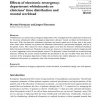Free Online Productivity Tools
i2Speak
i2Symbol
i2OCR
iTex2Img
iWeb2Print
iWeb2Shot
i2Type
iPdf2Split
iPdf2Merge
i2Bopomofo
i2Arabic
i2Style
i2Image
i2PDF
iLatex2Rtf
Sci2ools
HIJ
2016
2016
Effects of electronic emergency-department whiteboards on clinicians' time distribution and mental workload
Whiteboards are a central tool at emergency departments. We investigate how the substitution of electronic for dry-erase whiteboards affects emergency department clinicians’ mental workload and distribution of their time. With the electronic whiteboard, physicians and nurses spend more of their time in the work areas where other clinicians are present and whiteboard information is permanently displayed, and less in the patient rooms. Main reasons for these changes appear to be that the electronic whiteboard facilitates better timeouts and handovers. Physicians and nurses are, however, in the patient rooms for longer periods at a time, suggesting a more focused patient contact. The physicians’ mental workload has increased during timeouts, whereas the nurses’ mental workload has decreased at the start of shifts when they form an overview of the emergency department. Finally, the secretaries, but neither physicians nor nurses, access whiteboard information on computers other than ...
Biometrics | HIJ 2016 |
| Added | 03 Apr 2016 |
| Updated | 03 Apr 2016 |
| Type | Journal |
| Year | 2016 |
| Where | HIJ |
| Authors | Morten Hertzum, Jesper Simonsen |
Comments (0)

